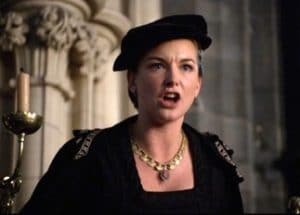
On this day in history, 18th June 1546, Anne Askew, estranged wife of Thomas Kyme, was found guilty of heresy at London’s Guildhall along with Nicholas Shaxton (former Bishop of Salisbury), Nicholas White and John Hadlam. All four of them were condemned to be burnt, but Shaxton and White were saved by recanting their heretical beliefs.
According to Anne herself, her account being published by martyrologist John Foxe, Nicholas Shaxton visited her in her prison and “counselled me to recant as he had done. I said to him, that it had been good for him never to have been born.” Anne was then put to the rack at the Tower of London by Sir Richard Rich and Sir Thomas Wriothesley, in the hope that she would give them the names of reformers at court, particularly ladies linked to Queen Catherine Parr.
Nicholas Shaxton died a natural death, dying on 5th August 1556, whereas Anne and John Hadlam were burnt at the stake on 16th July 1546 with reformers John Lascelles and John Hemley.
Read more about Anne Askew and her condemnation…
Also on this day in history, 18th June 1529, Queen Catherine of Aragon made her first appearance at the Legatine Court – click here to read more.